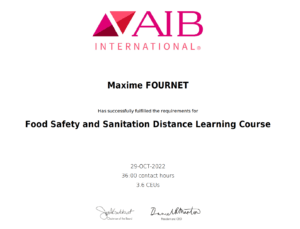General HACCP Standard
Hazard Analysis and Critical Control Points is a systematic preventive approach to food safety from biological, chemical, and physical hazards in production processes that can cause the finished product to be unsafe, and designs measurements to reduce these risks to a safe level. In this manner, HACCP is referred to as the prevention of hazards rather than finished product inspection. The HACCP system can be used at all stages of a food chain, from food production and preparation processes including packaging, distribution, etc.
Principles
-
Conduct a hazard analysis
- Plans determine the food safety hazards and identify the preventive measures the plan can apply to control these hazards. A food safety hazard is any biological, chemical, or physical property that may cause a food to be unsafe for human consumption.
-
Identify critical control points
- A critical control point (CCP) is a point, step, or procedure in a food manufacturing process at which control can be applied and, as a result, a food safety hazard can be prevented, eliminated, or reduced to an acceptable level.
-
Establish critical limits for each critical control point
- A critical limit is a maximum or minimum value to which a physical, biological, or chemical hazard must be controlled at a critical control point to prevent, eliminate, or reduce that hazard to an acceptable level.
-
Establish critical control point monitoring requirements
- Monitoring activities are necessary to ensure that the process is under control at each critical control point. It requires that each monitoring procedure and its frequency be listed in the HACCP plan.
-
Establish corrective actions
- These are actions to be taken when monitoring indicates a deviation from an established critical limit. The final rule requires a plant’s HACCP plan to identify the corrective actions to be taken if a critical limit is not met. Corrective actions are intended to ensure that no product is injurious to health or otherwise adulterated as a result if the deviation enters commerce.
-
Establish procedures for ensuring the HACCP system is working as intended
- Validation ensures that the plants do what they were designed to do; that is, they are successful in ensuring the production of a safe product. Plants will be required to validate their own HACCP plans. FSIS will not approve HACCP plans in advance but will review them for conformance with the final rule.
- Verification ensures the HACCP plan is adequate, that is, working as intended. Verification procedures may include such activities as a review of HACCP plans, CCP records, critical limits, and microbial sampling and analysis. The plan should include verification tasks to be performed by plant personnel. Verification tasks would also be performed by FSIS inspectors. Both FSIS and industry will undertake microbial testing as one of several verification activities.
- Verification also includes ‘validation’ – the process of finding evidence for the accuracy of the HACCP system (e.g. scientific evidence for critical limitations).
-
Establish record-keeping procedures
- The HACCP regulation requires that all plants maintain certain documents, including its hazard analysis and written HACCP plan, and records documenting the monitoring of critical control points, critical limits, verification activities, and the handling of processing deviations. Implementation involves monitoring, verifying, and validating of the daily work that is compliant with regulatory requirements in all stages all the time.
HACCP Standards
The seven HACCP principles are included in the international standard ISO 22000 FSMS 2005. This standard is complete food safety and quality management system incorporating the elements of prerequisite programs (GMP & SSOP), HACCP, and the quality management system, which together form an organization’s Total Quality Management system.
[source: wikipedia]

HACCP rules used in pest control
Pest control plays an important part in food safety. Troublesome insects such as cockroaches and flies can spread food-borne diseases by contaminating food at any stage of production. Rodents also spread diseases as well as causing damage to buildings, fixtures, and machinery. Stored product insects can damage and contaminate food during transport and storage.
Investing in pest control monitoring and detection helps prevent pests from entering a food processing establishment, thus assisting in the compliance of food safety. This includes respecting, among others, these rules:
Insecticides
– non-toxic or low toxicity products in kitchen and production area
– no spraying of insecticides
– avoid any thermal fogging which are harmful to health
– availability of the safety data of all the products used
Baits and bait stations
– ensure proper protection of the bait in a dedicated bait station for rodents
– clear signalization of the bait stations
– at least monthly checking of the consumption and report
– clear location of all the bait stations on a bait map
– non-dispersive baits


